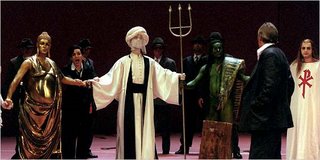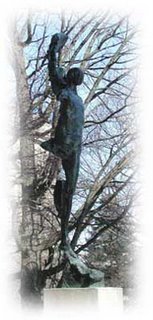The National Symphony Orchestra and Ilan Volkov, conductor, perform "... toward a Pure Land (2005)" by Jonathan Harvey
Sept 28 - 30, 2006.
"This work, completed last year, was commissioned by BBC Radio 3 for Ilan Volkov and the BBC Scottish Symphony Orchestra to perform in celebration of the restoration of Glasgow City Hall, as indeed they did on January 19 of this year. In the present concerts, the same conductor presides over the work's American premiere.
The score... calls for 3 flutes and piccolo; 3 oboes, 3 clarinets and bass clarinet; 3 bassoons, 5 horns, 3 trumpets, 3 trombones, tuba, crotales, glass chimes, a set of very high glass chimes (or metal ones), brass chimes, sizzle cymbal (with bow), 3 suspended cymbals (one with bow), 3 wood blocks, 5 temple blocks, 2 Tibetan bells, xylophone, vibraphone, large bell plate, mark tree, maracas, 2 Oriental finger cymbals, 2 triangles, tam-tam, slit drum, bass drum, 2 tom toms, 2 bongos, geophone, medium-small bamboo cluster, sandpaper blocks, celesta, harp, and strings. Duration, 15 minutes.
Jonathan Harvey began his active musical life as a chorister at St. Michael's College in Tenbury before undertaking his studies at St. John's College, Cambridge. He earned doctorates at Cambridge and at the University of Glasgow, and on Benjamin Britten's advice he studied privately with Hans Keller and Erwin Stein. He was a Harkness Fellow at Princeton in 1969-70, and his pedagogical activity has included a professorship at Stanford University from 1995 to 2000 as well as posts at several British institutions. He holds honorary doctorates from three British universities, one of these being Sussex University, where he served as professor of music from 1977 to 1933.
In the early 1980s Pierre Boulez invited Mr. Harvey to work at IRCAM, and that proved to be a lasting and productive connection, which has seen the creation of Mortuos Plango, a particularly successful piece for electronic tape, as well as several works in which electronic and pre-recorded sounds are combined with live performers. Mr. Harvey has also composed a good deal of music in the more conventional realms of opera, chamber music, choral works and orchestral ones. His orchestral work Madonna of Winter and Spring is to be introduced this fall by Sir Simon Rattle and the Berlin Philharmonic. His large-scale cantata Mothers Shall Not Cry was composed for and introduced in the BBC Proms Millennium of 2000. Following his church opera Passion and Resurrection, filmed by the BBC in 1981, he composed Inquest of Love under a commission from the English National Opera (1983), and his third opera, Wagner Dream, commissioned jointly by the Netherlands Opera, the Grand Théâtre de Luxembourg, the Holland Festival and IRCAM, will have its premiere next year. He is at work now on commissions from numerous performing organizations throughout Europe....
Mr. Harvey himself is the author of a book on inspiration and another on spirituality.
Last year Mr. Harvey took up the position of composer-in-association (equivalent to the post of "composer-in-residence" at several orchestras in our country) with BBC Scottish Symphony Orchestra in Glasgow. The present work, . . . towards a Pure Land, is the first of three which that appointment specified, and, as already noted, it was given its premiere last January under Ilan Volkov, who is conducting the present concerts. The score calls for some unusual and exotic instruments (see above), with some of the strings positioned at the back of their respective groups to form an "Ensemble of Eternal Sound"; these, the composers has written, "should be inconspicuous, 'hidden' sound." He calls also for the strings to "make very slow transitions between toneless noise (bow on the bridge) and normal tone, and vice versa," and to produce gradual changes in the sound, "from toneless to different shades of sul ponticello to naturale." The fifth horn is noted as "a bumper who occasionally plays independently." Further, the musicians are to contribute certain vocal effects."...
© Richard Freed 2006
http://www.kennedy-center.org/calendar/index.cfm?fuseaction=composition&composition_id=3740
*
From the Composer's Note for his publisher,
Faber Music:
"A small string ensemble, hidden on the stage, starts this work and stays peacefully behind the sound for much of the time. It is called the Ensemble of Eternal Sound. The main orchestra moves through varied types of idea until a central point, after which it moves progressively back to the first idea, making an arch, but an arch with developments. The centre itself is not solid, rather it is an emptiness, an empty presence. There is sound but only insubstantial pitch. In the surrounding music, the tempi are often fluid, the ideas are fleeting: things arise, then cease, in an unending flow. To grasp them and fix them would be to distort them falsely. A Pure Land is a state of mind beyond suffering where there is no grasping. It has also been described in Buddhist literature as landscape --a model of the world to which we can aspire.
Those who live there do not experience ageing, sickness or any other suffering. There is no poverty or fighting, and no danger from fire, water, wind or earth. The environment is completely pure, clean, and very beautiful, with mountains, lakes, trees and delightful birds revealing the meaning of Dharma. There are also gardens filled with heavenly flowers, bathing pools and exquisite jewels covering the ground which make it completely pure and smooth. 'Touching it gives rise to bliss'.
This work is the first fruit of the composer's association with the BBC Scottish Symphony Orchestra and their principal conductor, Ilan Volkov. It is the first of three commissions from them and is dedicated to them in gratitude.
© Jonathan Harvey and Faber Music
Amitabha Buddhist [Pure Land]Thangka Painting [detail] from Dharmapala Thangka Centre.
Image credit: via http://www2.bremen.de/info/ With thanks.















